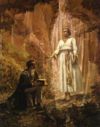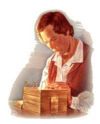The Book of Mormon: Another Testament of Jesus Christ[1] is one of the four standard works, or scriptures, of the Church of Jesus Christ of Latter-Day Saints (Mormons). The other standard works are the Bible, the Pearl of Great Price, and the Doctrine and Covenants.
Mormons believe that Joseph Smith, Jr. translated the Book of Mormon from a set of gold plates he received from an angel named Moroni[2]
“Joseph Smith would put the seer stone into a hat, and put his face in the hat, drawing it closely around his face to exclude the light; and in the darkness the spiritual light would shine. A piece of something resembling parchment would appear, and on that appeared the writing. One character at a time would appear, and under it was the interpretation in English. Brother Joseph would read off the English to Oliver Cowdery, who was his principal scribe, and when it was written down and repeated to Brother Joseph to see if it was correct, then it would disappear, and another character with the interpretation would appear. Thus the Book of Mormon was translated by the gift and power of God, and not by any power of man.” (David Whitmer, An Address to All Believers in Christ, Richmond, Mo.: n.p., 1887, p. 12.)
-Russell M. Nelson, “A Treasured Testament,” [3]
The Book of Mormon tells the story of the descendents of a man named Lehi, who took his family from Jerusalem to the Americas. According to the book, Lehi's wicked sons, Laman and Lemual, turned against his righteous sons, Nephi and Sam, and were cursed with dark skin[4]. Mormons believe that descendents of Lehi were the ancestors of some Native Americans; these people are referred to as "Lamanites" in the Book of Mormon:[5]
Nephi and Sam's descendents, the Nephites, eventually turned to wickedness and were destroyed by the more numerous Lamanites. One of the last Nephites, Moroni, buried the golden plates in what is now New York State to keep them from falling into the hands of the Lamanites and being destroyed.[6] Three Nephites were blessed with eternal life and still wander the Earth today serving others.[7]
A post-resurrection appearance in the New World by Jesus is also described in the Book of Mormon. In 1982, the subtitle, "Another Testament of Jesus Christ" was added to the title page[8].
Mormons and other Latter-Day Saints believe that the book is of ancient origin and that the personages and events described therein are factual. At the same time, Mormons deny that the book is to be considered inerrant. Its contents have been revised repeatedly by the Church authorities.
Historicity
The Book of Mormon is often criticized for a supposed lack of "evidence" and authenicity" which would be necessary to support the claimed Historical platform which it is built upon. However, Mormon apologists have made deep and detailed efforts to combat criticism from mainstream archaeologists. In the old world narrative in the first Book of the Book of Mormon (1 Nephi) apologists have made accurate discoveries of numerous locations thought not to have existed prior to discovery. An example of this is the discovery of the place known as "Nahom" as mentioned here ([http://lds.org/scriptures/bofm/1-ne/16.34?lang=eng#33) a burial place which was discovered and is referenced in no other text.[9]. Likewise Old world geography has been very accurately pinpointed by apologists.[10].
For the New World setting fo the Book of Mormon, there has been criticism directed towards the Book that numerous "Anachronisms" in regards to supposed items mentioned in the Book which are thought not to exist within the Americas, or accusations of alleged Anachronisms within the Book. Mormon Apologists though have worked to find counterarguments and responses to all of these claims in detail to draw more plausible debate around the Book[11]
Linguistically the Book of Mormon has infact been more positive. Linguists have worked to find links numerous between Hebrew and Native American languages[12]. At the same time there has been claimed linguistical anachronisms in the text, such as the mention of the French word "adieu". Though nonetheless the Book of Mormon been found to have numerous Semetic linguistic and literary traits within it which make it appear to be more authenitic, such as the inclusion of Chaismus[13] and numerous other Hebrew traits within the text[14]. Nonetheless, how much this fits in to confirmed evidence regarding pre-columbian America is largely limited and Mormon apologists do ultimately confess that the main evidence and support of the Book of Mormon does center upon ones very faith in it that it is a divinely inspired document.
Contents
The Book of Mormon: Another Testament of Jesus Christ [15] is divided up into many sections or parts, including a Title Page, Introduction, The Testimony of Three Witnesses, The Testimony of Eight Witnesses, the Testimony of the Prophet Joseph Smith, A Brief Explanation about The Book of Mormon, and the following main parts or divisions commonly referred to as "books," as in "The Book of Moroni," followed by the common abbreviation in parentheses:
- First Nephi (1 Ne.)
- Second Nephi (2 Ne.)
- Jacob (Jacob)
- Enos (Enos)
- Jarom (Jarom)
- Omni (Omni)
- Words of Mormon (W of M)
- Mosiah (Mosiah)
- Alma (Alma)
- Helaman (Hel.)
- Third Nephi (3 Ne.)
- Fourth Nephi (4 Ne.)
- Mormon (Morm.)
- Ether (Ether)
- Moroni (Moro.).
The first sentence of the Introduction is quite self-explanatory: "The Book of Mormon is a volume of holy scripture comparable to the Bible. It is a record of God’s dealings with the ancient inhabitants of the Americas and contains, as does the Bible, the fulness of the everlasting gospel." [16]
Other denominations
The Book of Mormon is also accepted as Scripture by some breakaway denominations, the largest of which, the Community of Christ (est. 1860), publishes its own versions of the Book of Mormon, with different chapter and verse divisions, and one with "modernized" language. Most other Christian denominations, Catholic and Protestant, reject the Book of Mormon as Scripture.
Polygamy
It should be noted that although the Book of Mormon generally forbids polygamy, it allows for its practice when divinely mandated, apparently for the purpose of raising righteous posterity. The Book of Mormon says the following concerning plural marriage:
"Wherefore, my bretheren, hear me, and hearken to the word of the Lord: For there shall not any man among you have save it be one wife, and concubines he shall have none... For if I will, saith the Lord of Hosts, raise up seed unto me, I will command my people; otherwise they shall hearken unto these things." (Jacob 2:27,30).
The revelation that authorized the practice of polygamy among Latter-day Saints during the 19th Century is recorded in the Doctrine and Covenants, section 132.
Notes and references
- ↑ The Book of Mormon; Title page since 1982: The Book of Mormon: Another Testament of Jesus Christ. Original title page: The Book of Mormon: An Account Written by the Hand of Mormon upon Plates Taken from the Plates of Nephi.
- ↑ "History of Joseph Smith," History of the Church Vol. 1
- ↑ "A Treasured Testament," Ensign, July 1993, 61
- ↑ GospelDoctrine.com
- ↑ Elder Spencer W. Kimball of the Quorum of the Twelve Apostles
- ↑ The Book of Mormon
- ↑ "Clyde J. Williams on the Three Nephites and the Doctrine of Translation," Thoughts on Gospel Doctrine Lesson 42, Deseret Book.
- ↑ A Short Introduction to the Book of Mormon
- ↑ FAIR Wiki- Mormon Apologetic resource- Nahom
- ↑ [1]
- ↑ [2]
- ↑ [3]
- ↑ Chiasmus
- ↑ [4]
- ↑ http://scriptures.lds.org/en/bm/contents
- ↑ http://scriptures.lds.org/en/bm/introduction
External Links
- The Book of Mormon - An online edition
- The Logical Arguments of the Book of Mormon, Kelly Bingham, November 1, 1997

